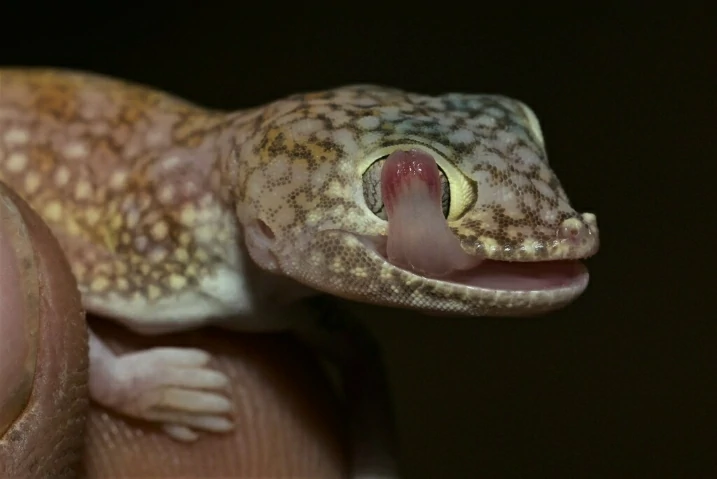Have you ever watched a gecko snap up a bug and wondered how it actually eats? Some reptiles, like snakes, just swallow their food whole. Others have teeth to tear things apart.
If you’ve ever looked closely at a gecko or even got nipped by one, you might be curious about what’s in their mouth. So, do geckos have teeth?
Yes, geckos have teeth. Most geckos have around 100 tiny, sharp teeth in rows along their upper and lower jaws. They’re not for chewing, but for gripping bugs. Geckos use them to catch insects and make sure they don’t escape before swallowing them whole.
Their teeth are small and pointy, just right for catching bugs. You might not notice them at first, but they’re really important for how geckos eat.
What Gecko Teeth Look Like
Gecko teeth are nothing like human teeth, and even different from other reptiles.
Research on gecko dental structure shows they’re tiny, cone-shaped, and very sharp. They point slightly backward toward the throat. That way, once a bug is caught, it can’t wriggle away.

The teeth grow in rows along the jaw. Most geckos have several rows. The front teeth work while new teeth grow behind them.
Each tooth is just a few millimeters long. In small geckos, you’d need a magnifying glass to see them. Even big geckos, like tokays, have pretty small teeth.
The teeth are white or see-through and blend in with the inside of the mouth. That’s why you usually can’t see them unless the gecko bites something.
They’re thin and delicate. Made to pierce soft bug bodies, not crush hard shells or tear tough food.
What Geckos Use Their Teeth For
Geckos use their teeth to grab and hold food, not to chew.
When a gecko strikes a bug, it pierces the bug’s shell and holds on tight. The backward teeth make it hard for the bug to escape.
Geckos don’t chew. They just hold the bug in their mouth and swallow it whole or in big chunks. Their teeth hold the bug while they use their tongue and throat to push it down.
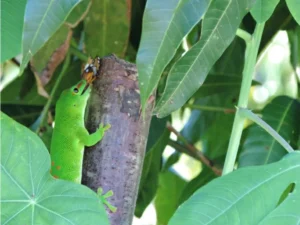
Sometimes geckos bite bigger bugs a few times to subdue them before swallowing.
Geckos can also use their teeth for defense. If one bites you, the tiny teeth might break your skin. It usually doesn’t hurt much. They’re more to warn predators than cause real harm.
Male geckos sometimes use their teeth during mating. They’ll bite the female’s neck or back to hold her in place. It’s normal and usually doesn’t hurt her.
Do Gecko Teeth Fall Out?
Humans lose baby teeth once, but geckos keep replacing their teeth for life.
They have what scientists call polyphyodont dentition, which just means new teeth grow all the time to replace old or broken ones. This is normal for reptiles and very different from mammals.
A gecko can replace a tooth in just a few weeks. The new tooth grows behind the old one, and when the old tooth falls out, the new one moves forward.
This is important because gecko teeth are fragile. They can break when catching hard-shelled bugs. Without replacement, they could lose all their teeth and starve.
Sometimes you might see tiny white specks in your gecko’s tank. Those are shed teeth. Totally normal.
The replacement system means geckos always have working teeth, no matter how old they get. A 10-year-old gecko has just as many teeth as a 1-year-old.
Can Gecko Bites Break Skin?
If a gecko bite breaks skin depends on the gecko’s size and type.
Small house geckos have tiny teeth, so bites rarely break skin. You might feel a pinch, but no blood. Their teeth are too small to go deep.
Medium geckos, like leopard geckos, can sometimes scratch the skin. Their teeth and jaws are bigger, but it’s usually just a little mark.
Big geckos, like tokays, can break skin. They have bigger teeth and stronger jaws, so bites can sometimes bleed a bit.
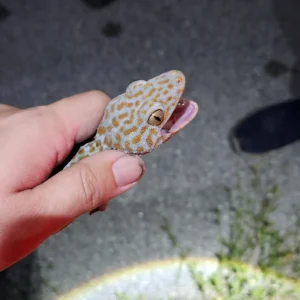
Even then, a gecko bite is minor compared to a cat or dog bite. Their jaws aren’t strong enough to really hurt you.
Most bites happen when a gecko is scared or cornered. They’d rather run than bite. Handle them gently, and you’ll probably never get bitten.
Do All Geckos Have the Same Type of Teeth?
All geckos have teeth, but there are differences between species.
Most have pleurodont teeth, which means teeth attach to the side of the jaw instead of sitting in sockets like humans. This is normal for lizards.
The number of teeth varies. Small geckos might have 80-100, while bigger ones can have 100-150 or more. In general, bigger geckos usually have more teeth.
Some geckos have different shapes. Bugs with hard shells need slightly thicker teeth. Soft-bodied bugs need thinner, needle-like teeth.
Day geckos, which eat some fruit as well as bugs, have teeth that hold insects but won’t damage soft fruit.
Leaf-tailed geckos have bigger teeth for their size because they sometimes eat larger prey, including other small lizards.
How Sharp Are Gecko Teeth?
Even tiny teeth are very sharp.
They need to pierce insect shells. Crickets and beetles have tough shells that geckos need to get through.
If a gecko bites you, you’ll feel it. Like many tiny needles pricking you at once.
The teeth help hold struggling prey. When a bug wriggles, the teeth dig in and make it hard to escape.
Gecko teeth aren’t for cutting. They’re for piercing, which is why geckos swallow food whole.
Teeth dull a bit with use, but new teeth grow constantly, so they’re always ready.
Do Baby Geckos Have Teeth?
Baby geckos, called hatchlings, are born with teeth.
Unlike human babies, who are toothless, gecko hatchlings need teeth to start hunting bugs right away. They don’t get milk or care from parents, so they must eat on their own from day one.
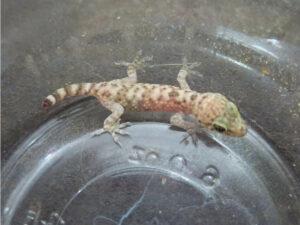
Their teeth are the same shape as adults, just smaller. A baby house gecko might have 50-80 teeth, while an adult of the same species has 100 or more.
As they grow, they add teeth and replace old ones. Even in the egg, gecko embryos grow teeth so they’re ready to eat once hatched.
Caring for Your Pet Gecko’s Teeth
If you have a pet gecko, its teeth usually take care of themselves.
The natural replacement system means you don’t need to brush their teeth like a dog or cat. Geckos are built to handle it.
You should give good food to support healthy teeth. Feed a variety of insects and dust them with calcium and vitamins as needed.
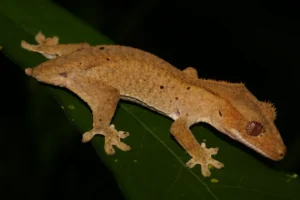
Low calcium can cause metabolic bone disease, which affects teeth and jaw strength
If your gecko struggles to catch or hold food, check for swelling, color changes, or jaw damage. Take your gecko to a reptile vet if something looks off.
Mouth rot, a bacterial infection, can also affect teeth. It usually comes from poor tank conditions or injury. Keeping the tank clean and at the right temperature helps prevent it.
Can Geckos Bite Through Things?
Geckos can bite soft things but not hard materials.
They can pierce insect shells but not fabric, leather, wood, or anything tough. Their jaws are too weak.
If a gecko bites your finger, it might break the skin. That’s it. No fingernails, thick gloves, or hard surfaces.
Even big tokay geckos can’t chew mesh or plastic tanks. They might bite if stressed, but they won’t damage anything.
This is actually good for pet owners. Geckos catch bugs but don’t destroy cages or stuff. They’re built for eating insects, not chewing everything up.
Conclusion
Geckos have teeth, and a lot of them. Tiny, sharp teeth that are perfect for catching and holding insects.
You might not see them, but they’re always there, helping geckos survive. The replacement system makes sure they never run out, no matter how many break.
If you keep geckos as pets, their teeth take care of themselves. Just give good food and care, and their teeth will stay healthy for life.
Those tiny, invisible teeth are part of what makes geckos such effective bug hunters.
Hi, my name is Ezra Mushala, i have been interested animals all my life. I am the main author and editor here at snakeinformer.com.

